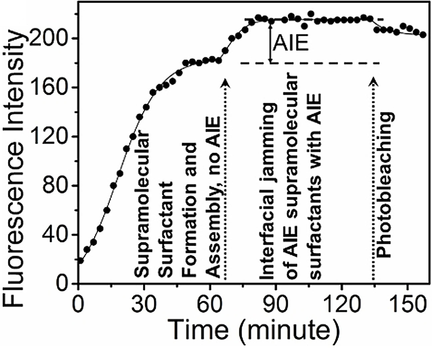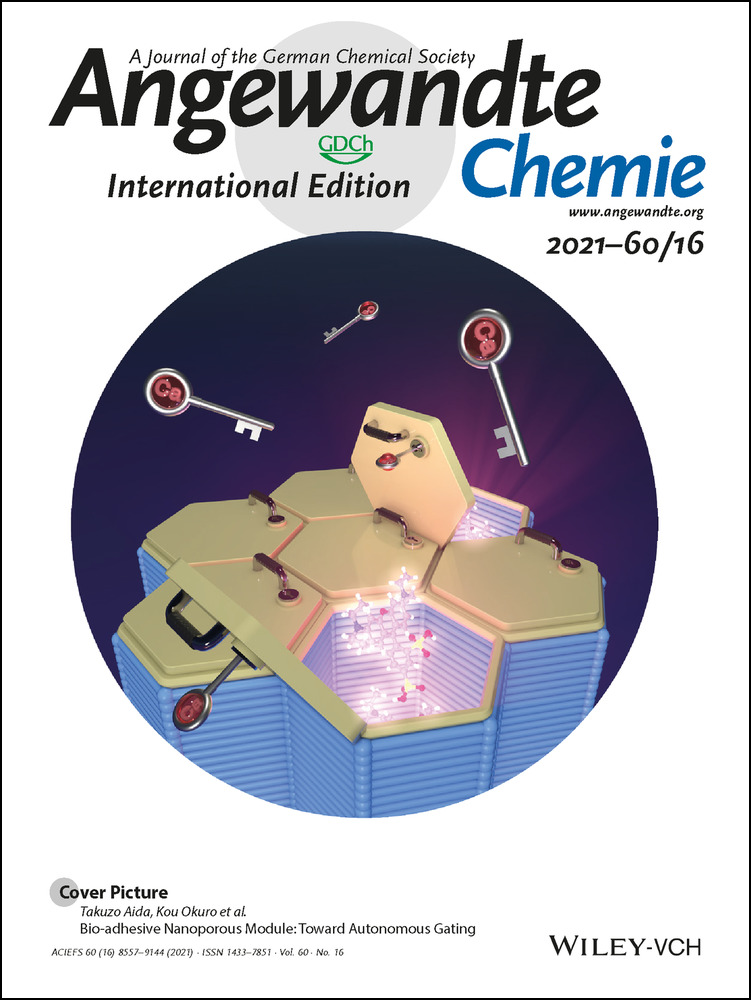Visualizing Interfacial Jamming Using an Aggregation-Induced-Emission Molecular Reporter
Dr. Pei-Yang Gu
College of Chemistry, Chemical Engineering and Materials Science, Collaborative Innovation Center of Suzhou Nano Science and Technology, Soochow University, Suzhou, 215123 China
Materials Sciences Division, Lawrence Berkeley National Laboratory, 1 Cyclotron Road, Berkeley, CA, 94720 USA
These authors contributed equally to this work.
Search for more papers by this authorDr. Feng Zhou
College of Chemistry, Chemical Engineering and Materials Science, Collaborative Innovation Center of Suzhou Nano Science and Technology, Soochow University, Suzhou, 215123 China
These authors contributed equally to this work.
Search for more papers by this authorDr. Ganhua Xie
Materials Sciences Division, Lawrence Berkeley National Laboratory, 1 Cyclotron Road, Berkeley, CA, 94720 USA
These authors contributed equally to this work.
Search for more papers by this authorDr. Paul Y. Kim
Materials Sciences Division, Lawrence Berkeley National Laboratory, 1 Cyclotron Road, Berkeley, CA, 94720 USA
Search for more papers by this authorDr. Yu Chai
Department of Physics, City University of Hong Kong, Kowloon, China
Search for more papers by this authorDr. Qin Hu
Materials Sciences Division, Lawrence Berkeley National Laboratory, 1 Cyclotron Road, Berkeley, CA, 94720 USA
School of Microelectronics, University of Science and Technology of China, Hefei, Anhui, 230026 China
Polymer Science and Engineering Department, University of Massachusetts, Amherst, MA, 01003 USA
Search for more papers by this authorDr. Shaowei Shi
Beijing Advanced Innovation Center for Soft Matter Science and Engineering, Beijing University of Chemical Technology, Beijing, 100029 China
Search for more papers by this authorProf. Qing-Feng Xu
College of Chemistry, Chemical Engineering and Materials Science, Collaborative Innovation Center of Suzhou Nano Science and Technology, Soochow University, Suzhou, 215123 China
Search for more papers by this authorDr. Feng Liu
Department of Physics and Astronomy, Collaborative Innovation Center of IFSA (CICIFSA), Shanghai Jiaotong University, Shanghai, 200240 P. R. China
Search for more papers by this authorCorresponding Author
Prof. Jian-Mei Lu
College of Chemistry, Chemical Engineering and Materials Science, Collaborative Innovation Center of Suzhou Nano Science and Technology, Soochow University, Suzhou, 215123 China
Search for more papers by this authorCorresponding Author
Prof. Thomas P. Russell
Materials Sciences Division, Lawrence Berkeley National Laboratory, 1 Cyclotron Road, Berkeley, CA, 94720 USA
Polymer Science and Engineering Department, University of Massachusetts, Amherst, MA, 01003 USA
Beijing Advanced Innovation Center for Soft Matter Science and Engineering, Beijing University of Chemical Technology, Beijing, 100029 China
Advanced Institute for Materials Research (WPI-AIMR), Tohoku University, 2-1-1 Katahira, Aoba, Sendai, 980-8577 Japan
Search for more papers by this authorDr. Pei-Yang Gu
College of Chemistry, Chemical Engineering and Materials Science, Collaborative Innovation Center of Suzhou Nano Science and Technology, Soochow University, Suzhou, 215123 China
Materials Sciences Division, Lawrence Berkeley National Laboratory, 1 Cyclotron Road, Berkeley, CA, 94720 USA
These authors contributed equally to this work.
Search for more papers by this authorDr. Feng Zhou
College of Chemistry, Chemical Engineering and Materials Science, Collaborative Innovation Center of Suzhou Nano Science and Technology, Soochow University, Suzhou, 215123 China
These authors contributed equally to this work.
Search for more papers by this authorDr. Ganhua Xie
Materials Sciences Division, Lawrence Berkeley National Laboratory, 1 Cyclotron Road, Berkeley, CA, 94720 USA
These authors contributed equally to this work.
Search for more papers by this authorDr. Paul Y. Kim
Materials Sciences Division, Lawrence Berkeley National Laboratory, 1 Cyclotron Road, Berkeley, CA, 94720 USA
Search for more papers by this authorDr. Yu Chai
Department of Physics, City University of Hong Kong, Kowloon, China
Search for more papers by this authorDr. Qin Hu
Materials Sciences Division, Lawrence Berkeley National Laboratory, 1 Cyclotron Road, Berkeley, CA, 94720 USA
School of Microelectronics, University of Science and Technology of China, Hefei, Anhui, 230026 China
Polymer Science and Engineering Department, University of Massachusetts, Amherst, MA, 01003 USA
Search for more papers by this authorDr. Shaowei Shi
Beijing Advanced Innovation Center for Soft Matter Science and Engineering, Beijing University of Chemical Technology, Beijing, 100029 China
Search for more papers by this authorProf. Qing-Feng Xu
College of Chemistry, Chemical Engineering and Materials Science, Collaborative Innovation Center of Suzhou Nano Science and Technology, Soochow University, Suzhou, 215123 China
Search for more papers by this authorDr. Feng Liu
Department of Physics and Astronomy, Collaborative Innovation Center of IFSA (CICIFSA), Shanghai Jiaotong University, Shanghai, 200240 P. R. China
Search for more papers by this authorCorresponding Author
Prof. Jian-Mei Lu
College of Chemistry, Chemical Engineering and Materials Science, Collaborative Innovation Center of Suzhou Nano Science and Technology, Soochow University, Suzhou, 215123 China
Search for more papers by this authorCorresponding Author
Prof. Thomas P. Russell
Materials Sciences Division, Lawrence Berkeley National Laboratory, 1 Cyclotron Road, Berkeley, CA, 94720 USA
Polymer Science and Engineering Department, University of Massachusetts, Amherst, MA, 01003 USA
Beijing Advanced Innovation Center for Soft Matter Science and Engineering, Beijing University of Chemical Technology, Beijing, 100029 China
Advanced Institute for Materials Research (WPI-AIMR), Tohoku University, 2-1-1 Katahira, Aoba, Sendai, 980-8577 Japan
Search for more papers by this authorGraphical Abstract
With the interfacial jamming of nanoparticles (NPs), a load-bearing network of NPs forms as the areal density of NPs increases, converting a liquid-like assembly into a solid-like assembly. Real-time fluorescence imaging has been used to probe the evolution of the interfacial dynamics of nanoparticle surfactants at the water/oil interface by using aggregation-induced emission as a reporter for the transition of the assemblies into the jammed state (see graph).
Abstract
With the interfacial jamming of nanoparticles (NPs), a load-bearing network of NPs forms as the areal density of NPs increases, converting the assembly from a liquid-like into a solid-like assembly. Unlike vitrification, the lineal packing of the NPs in the network is denser, while the remaining NPs can remain in a liquid-like state. It is a challenge to determine the point at which the assemblies jam, since both jamming and vitrification lead to a solid-like behavior of the assemblies. Herein, we show a real-time fluorescence imaging method to probe the evolution of the interfacial dynamics of NP surfactants at the water/oil interface using aggregation-induced emission (AIE) as a reporter for the transition of the assemblies into the jammed state. The AIEgens show typical fluorescence behavior at densities at which they can move and rotate. However, when aggregation of these fluorophores occurs, the smaller intermolecular separation distance arrests rotation, and a significant enhancement in the fluorescence intensity occurs.
Supporting Information
As a service to our authors and readers, this journal provides supporting information supplied by the authors. Such materials are peer reviewed and may be re-organized for online delivery, but are not copy-edited or typeset. Technical support issues arising from supporting information (other than missing files) should be addressed to the authors.
| Filename | Description |
|---|---|
| anie202016217-sup-0001-misc_information.pdf1.4 MB | Supplementary |
| anie202016217-sup-0001-Video_S1.avi1.1 MB | Supplementary |
| anie202016217-sup-0001-Video_S2.avi1,016.1 KB | Supplementary |
Please note: The publisher is not responsible for the content or functionality of any supporting information supplied by the authors. Any queries (other than missing content) should be directed to the corresponding author for the article.
References
- 1
- 1aZ. Yang, J. Wei, Y. I. Sobolev, B. A. Grzybowski, Nature 2018, 553, 313–318;
- 1bL. D. Zarzar, V. Sresht, E. M. Sletten, J. A. Kalow, D. Blankschtein, T. M. Swager, Nature 2015, 518, 520–524;
- 1cY. Zheng, Z. Yu, R. M. Parker, Y. Wu, C. Abell, O. A. Scherman, Nat. Commun. 2014, 5, 5772;
- 1dY. Chao, H. C. Shum, Chem. Soc. Rev. 2020, 49, 114–142;
- 1eC. Buten, L. Kortekaas, B. J. Ravoo, Adv. Mater. 2020, 32, 1904957;
- 1fR. T. Shafranek, S. C. Millik, P. T. Smith, C.-U. Lee, A. J. Boydston, A. Nelson, Prog. Polym. Sci. 2019, 93, 36–67.
- 2
- 2aM. Cui, T. Emrick, T. P. Russell, Science 2013, 342, 460–463;
- 2bR. Luo, J. Dong, X. Li, Y. Luo, Colloid Polym. Sci. 2020, 298, 419–433.
- 3
- 3aH. M. Jaeger, Soft Matter 2015, 11, 12–27;
- 3bC. Huang, J. Forth, W. Wang, K. Hong, G. S. Smith, B. A. Helms, T. P. Russell, Nat. Nanotechnol. 2017, 12, 1060–1063;
- 3cP. Y. Gu, Y. Chai, H. Hou, G. Xie, Y. Jiang, Q. F. Xu, F. Liu, P. D. Ashby, J. M. Lu, T. P. Russell, Angew. Chem. Int. Ed. 2019, 58, 12112–12116; Angew. Chem. 2019, 131, 12240–12244.
- 4
- 4aZ. Niroobakhsh, J. A. LaNasa, A. Belmonte, R. J. Hickey, Phys. Rev. Lett. 2019, 122, 178003;
- 4bX. Liu, N. Kent, A. Ceballos, R. Streubel, Y. Jiang, Y. Chai, P. Y. Kim, J. Forth, F. Hellman, S. Shi, Science 2019, 365, 264–267.
- 5
- 5aW. Feng, Y. Chai, J. Forth, P. D. Ashby, T. P. Russell, B. A. Helms, Nat. Commun. 2019, 10, 1095;
- 5bG. Xie, J. Forth, Y. Chai, P. D. Ashby, B. A. Helms, T. P. Russell, Chem 2019, 5, 2678–2690;
- 5cX. Hua, M. A. Bevan, J. Frechette, Langmuir 2018, 34, 4830–4842.
- 6
- 6aG. Luo, Y. Yu, Y. Yuan, X. Chen, Z. Liu, T. Kong, Adv. Mater. 2019, 31, 1904631;
- 6bL. Tran, M. F. Haase, Langmuir 2019, 35, 8584–8602;
- 6cJ. Forth, X. Liu, J. Hasnain, A. Toor, K. Miszta, S. Shi, P. L. Geissler, T. Emrick, B. A. Helms, T. P. Russell, Adv. Mater. 2018, 30, 1707603.
- 7J. Luo, Z. Xie, J. W. Lam, L. Cheng, H. Chen, C. Qiu, H. S. Kwok, X. Zhan, Y. Liu, D. Zhu, B. Z. Tang, Chem. Commun. 2001, 1740–1741.
- 8
- 8aZ. Wei, Z. Y. Gu, R. K. Arvapally, Y. P. Chen, R. N. McDougald, Jr., J. F. Ivy, A. A. Yakovenko, D. Feng, M. A. Omary, H. C. Zhou, J. Am. Chem. Soc. 2014, 136, 8269–8276;
- 8bW. Guan, S. Wang, C. Lu, B. Z. Tang, Nat. Commun. 2016, 7, 11811;
- 8cY. L. Ying, Y. J. Li, J. Mei, R. Gao, Y. X. Hu, Y. T. Long, H. Tian, Nat. Commun. 2018, 9, 3657.
- 9
- 9aW. Guan, W. Zhou, C. Lu, B. Z. Tang, Angew. Chem. Int. Ed. 2015, 54, 15160–15164; Angew. Chem. 2015, 127, 15375–15379;
- 9bZ. Li, P. Liu, X. Ji, J. Gong, Y. Hu, W. Wu, X. Wang, H. Q. Peng, R. T. K. Kwok, J. W. Y. Lam, J. Lu, B. Z. Tang, Adv. Mater. 2020, 32, 1906493.
- 10
- 10aK. G. Marinova, R. G. Alargova, N. D. Denkov, O. D. Velev, D. N. Petsev, I. B. Ivanov, R. P. Borwankar, Langmuir 1996, 12, 2045–2051;
- 10bJ. K. Beattie, A. M. Djerdjev, Angew. Chem. Int. Ed. 2004, 43, 3568–3571; Angew. Chem. 2004, 116, 3652–3655;
- 10cJ. Stachurski, M. Michałek, J. Colloid Interface Sci. 1996, 184, 433–436;
- 10dP. Creux, J. Lachaise, A. Graciaa, J. K. Beattie, A. M. Djerdjev, J. Phys. Chem. B 2009, 113, 14146–14150;
- 10eD. E. Dunstan, J. Colloid Interface Sci. 1994, 166, 472–475.





